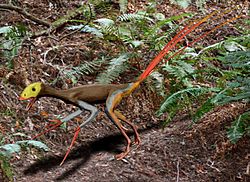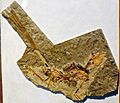Epidexipteryx facts for kids
Quick facts for kids EpidexipteryxTemporal range: ? Upper Jurassic
|
|
|---|---|
 |
|
| Scientific classification | |
| Kingdom: | |
| Class: | |
| Superorder: | |
| Order: | |
| Suborder: | |
| (unranked): | |
| Genus: |
Epidexipteryx
Zhang et al. 2008
|
Epidexipteryx (say "Ep-ih-dex-ip-ter-ix") means 'display feather'. It was a small, bird-like dinosaur called a maniraptoran. Scientists found only one fossil of Epidexipteryx in Beijing, China.
This dinosaur is special because it has the oldest known ornamental feathers found in fossils! These feathers were likely used for showing off, not for flying. Epidexipteryx lived about 160 to 168 million years ago. This was during the Middle or Upper Jurassic period.
What Epidexipteryx Looked Like
Scientists found a very well-preserved fossil skeleton of Epidexipteryx. It had four long feathers on its tail. These feathers had a central stalk and flat parts, but they were different from modern bird feathers. Instead of being fluffy, they were like flat, ribbon-like sheets. Epidexipteryx also had simpler feathers covering its body. Some of these feathers seemed to grow from a thin, skin-like part.
The whole skeleton of Epidexipteryx hui was about 25 centimeters (10 inches) long. If you include its long tail feathers, it was about 44.5 centimeters (17.5 inches). Scientists think it weighed around 164 grams. This makes it smaller than most other early bird-like dinosaurs.
The skull of Epidexipteryx was also quite unique. It only had teeth at the very front of its jaws. These front teeth were unusually long and pointed forward. This is a feature only seen in one other type of meat-eating dinosaur called Masiakasaurus. The tail of Epidexipteryx had special bones near the tip. These bones were similar to the pygostyle found in modern birds. A pygostyle is a fused bone that helps anchor tail feathers.
Even though Epidexipteryx was closely related to birds, it did not have wing feathers. This means it could not fly. Scientists believe that the fancy display feathers on its tail might have appeared before dinosaurs developed the ability to fly or glide.
How Old Is It?
There is some debate about the exact age of the rocks where this fossil was found. These rocks are called the Daohugou Beds. Some scientists think the fossils are from the Middle Jurassic period (about 169 million years ago). Others believe they are from the Lower Cretaceous period (about 122 million years ago).
Knowing the correct age of this rock formation is important. It helps scientists understand how different dinosaurs are related. It also helps us learn more about where birds came from. If the Daohugou Beds are from the Middle Jurassic, it would mean that bird-like dinosaurs like Epidexipteryx are older than Archaeopteryx. Archaeopteryx is often called the 'first bird' and lived in the late Jurassic period. Until scientists agree on the age, the full importance of Epidexipteryx and other early bird-like dinosaurs from this area is not completely clear.
Images for kids
-
The scansoriopterygid genera Epidexipteryx (orange), Yi (green), and Scansoriopteryx (red) compared to a human in size
See also
 In Spanish: Epidexipteryx hui para niños
In Spanish: Epidexipteryx hui para niños






